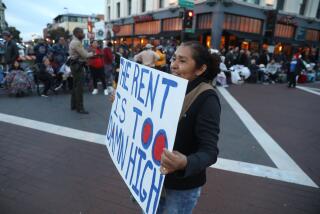Loan risk spreads far and wide
- Share via
WASHINGTON — Americans are learning a painful lesson from the financial market turmoil: One of the qualities that make the modern U.S. system so powerful -- its ability to spread the risk of funding loans across millions of investors around the world -- turns out to have a damaging weakness built into it.
With ownership and risk spread far and wide, no one investor is likely to have too much exposure if something goes wrong. But the little-recognized flip side of that reassuring strategy is that no one can be sure exactly who is sharing in the risk.
And this uncertainty -- brought to the surface by trouble in the sub-prime home mortgage market -- is now setting off exactly the sort of panic that the new system of spreading risk was supposed to prevent.
“We supposed that if we atomized the risk of loan, it wouldn’t come back to bite us,” said Robert Litan, a senior economist with the Brookings Institution in Washington. “What we’re learning is that no matter how widely you spread the risk, it doesn’t go away.
“You can divide and divide and divide and divide it, and the risk is still there.”
What makes that discovery a problem is that when risky loans are packaged and repackaged into ever-more complex securities and sold to investors all over the world, it’s almost impossible to tell who’s holding a piece of the bad paper and who’s not. As a result, reassuring investors and calming jumpy markets have become very difficult.
Nervous investors have begun shying away from all sorts of seemingly sound investment opportunities -- apparently on the theory that it’s better to be safe than sorry.
The problem is particularly troubling because the new system, which is designed to let lenders and borrowers go directly to the financial markets rather than work through banks, as most traditionally did, doesn’t square with the nation’s regulatory institutions.
Those institutions were set up to provide a guiding hand for banks, not markets, and provide insurance for depositors, not investors. The result has been to further increase the chance for panic. “By taking the bank out of the middle and having individual investors make direct investments, you leave them more exposed,” said Robert J. Barbera, chief economist with brokerage ITG in Rye, N.Y.
“If investments go sour, there’s no [Federal Deposit Insurance Corp.] to protect them and keep them from trying to get out all at once.”
The combination of not being able to get a clear picture of who’s bearing the risks and the fact that, unlike bank depositors, investors are fully exposed to loss should something go wrong helps explain one of the great mysteries of the current situation: how problems in such a comparatively small segment of the financial markets could produce such outsize effects.
The sub-prime mortgages at the center of the current uproar are home loans made to people with shaky credit histories. Also involved are other risky mortgages, including interest-only and various adjustable-rate loans.
In recent years, it has become common for lenders to bundle such loans into packages that were “securitized” -- sold to investors, who shared some of the risk.
Taken together, the value of these loans is an estimated $2.5 trillion, according to Moody’s Economy.com. Although that’s hardly an inconsequential sum, it represents less than 2% of the roughly $175 trillion in equity value and bank and bond debt outstanding worldwide, seemingly not enough to rattle world financial markets.
One of the ironies of the present problem is that the arrangement of having loans largely financed directly by investors (rather than indirectly by depositors through banks) emerged out of frustration with the banking system during the savings and loan crisis of the late 1980s and the Third World debt debacle of the late 1980s and early 1990s.
Then, bankers made wild loans in hopes of large profits, only to watch many go bad. In the case of the S&Ls;, the government spent more than $150 billion taking over institutions and paying off depositors.
Out of the crisis emerged an idea that seemed -- at least until recent days -- to be one of the great financial innovations of the last generation. Instead of relying on the tiny reserves of a single institution, borrowers and lenders could go directly to the global credit market.
And instead of counting on a single institution to bear the risk that a loan might go sour, lenders could sell packages of loans -- and even shares of those packages -- to investors across the planet.
The use of financial markets and securitization promised to bring capitalist discipline to an area where government regulation had so evidently failed.
Policymakers were aware that in allowing the regulated world of the banks to be supplanted by the markets, they were substantially changing the rules of the game.
They believed, however, that the market would provide its own protections.
Debt-rating firms such as Moody’s and Standard & Poor’s would enforce the quality of mortgage-backed securities. By appearing ready to step in if markets became too turbulent, then-Federal Reserve Chairman Alan Greenspan seemed to offer something like FDIC insurance -- an assurance that they would not lose -- to investors.
And unlike a typical stock whose fate fluctuates with that of its company, the value of mortgage-backed securities seemed tethered to something of continuing value -- the houses on which mortgages were written.
But from the vantage point of today, those protections seem to have been wildly overblown. The rating firms overestimated the safety and soundness of many, perhaps most, mortgage packages, at least in part because with housing in most places having only appreciated for decades, there was little reason to see much danger in the securities.
Greenspan was more willing to tolerate market turbulence than his reputation suggested and, in any case, was succeeded by a new Fed chairman, Ben S. Bernanke, who at least until this week seemed intent on not intervening to smooth out market ups and downs.
And many of the mortgages -- written by lightly regulated brokers rather than bankers -- have turned out to be too big compared with the value of the property on which they were made.
“Mortgage lending, effectively, is not regulated,” said Yale finance theorist Robert Shiller, who gained national prominence for warning of the stock bubble of the late 1990s and more recently has been warning of a housing bubble.
“Mortgage lenders have been too generous. The market is a mess,” he said.
In such circumstances, the government’s only real tool to try to straighten out matters is opening the money spigot, which the Federal Reserve and the European, Japanese and Australian central banks did in spades Thursday and Friday.
But with doubts about the quality of mortgage packages and uncertainties about who faces how much risk, it seems unlikely that the market for the securities will snap back quickly.
That, analysts say, suggests the possibility of a nasty downward cycle in which mortgage money dries up, pushing down already sagging house prices. In turn, such a process could send the value of mortgage-backed securities still lower.
“There’s another tough leg down to come for housing, and it’s not clear where the bottom is,” Barbera said.
--
More to Read
Inside the business of entertainment
The Wide Shot brings you news, analysis and insights on everything from streaming wars to production — and what it all means for the future.
You may occasionally receive promotional content from the Los Angeles Times.










